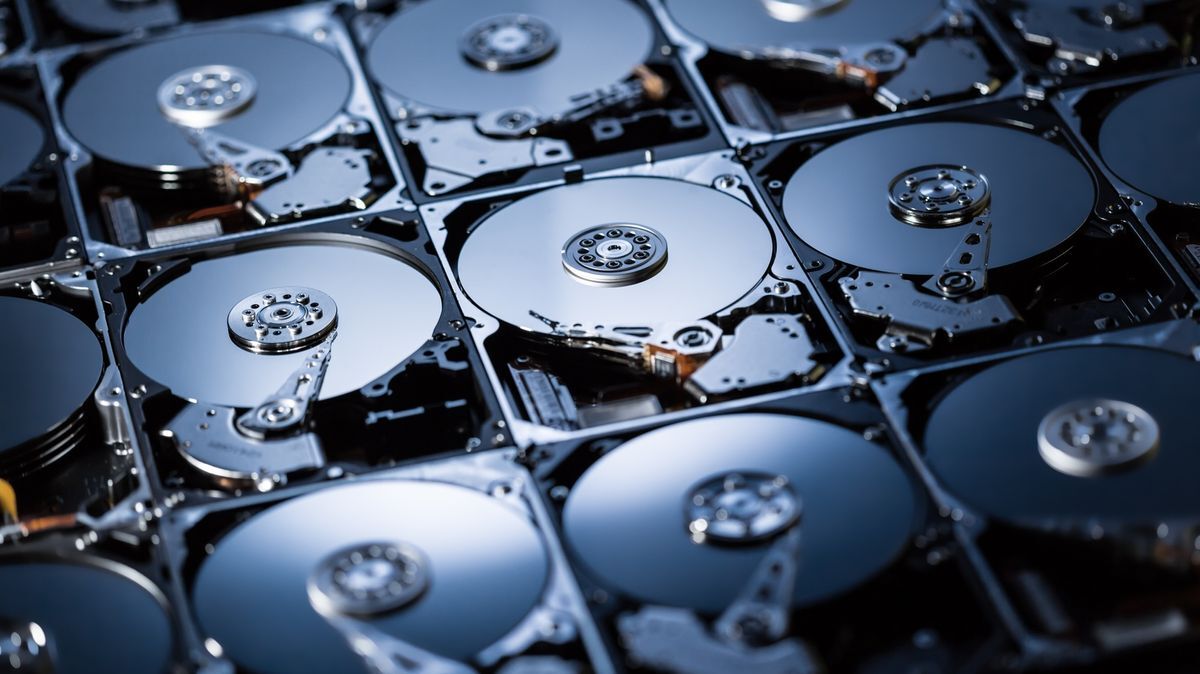Person with vested interest in X says X will continue to proliferate. More at 11
Also, for some extra context:
Could have said more at 10 (X) 😁
on X (the artist formerly known as Twitter)
Stupid elon
Haven’t hard drives been cheaper per storage amount than SSDs forever? The problem was always that they were slow. I think tape may still be cheaper per storage amount than hard drives, but the speed is abysmal.
Edit: yeah looks like tape is 3x to 4x cheaper than hard drives https://corodata.com/tape-backups-still-used-today
Tape will be around until something better for archival purposes comes around
It lasts significantly longer sitting on the shelf than HDD or SSD by far
I doubt it’s being used for anything other than backups and archiving though
It’s also used for sending huge amounts of data long distances. “Never underestimate the bandwidth of a station wagon full of tapes hurtling down the highway.” That’s usually attributed to Andrew S. Tanenbaum, but wikipedia follows that with “other alleged speakers include…” so take that with a grain of salt. They do note that the first problem in his book on computer networks asks students to calculate the throughput of a Saint Bernard carrying floppy disks.
Do we assume the Saint Bernard is spherical and ignores air resistance?
No, it’s for real. The bandwidth of sending a truckload of disks to a destination can get to literally Tbps speeds. Latency is a different problem
Oh, I’m aware. Just making a tongue in cheek physics joke since they said he put that problem in a textbook.
Amazon is using trucks to ship hard drives for the largest data transfers. It’s more efficient than doing it over internet. They also offer a service where they will put the data you want in a drive, mail it to you, and after you’re done, you send the drive back.
Microsoft Azure Data Box Disk is also available.
https://learn.microsoft.com/en-us/azure/databox/data-box-disk-overview
It’s criminal that some computers are still sold with mechanical hard drives, but I will still be using them in NAS for years to come. The right technology for the right job.
I only use them in my NAS because I keep ending up with spare ones.
That’s where I have a theory about when the hard drive market will collapse. A lot of networked drive setups have 4 drives on RAID 10. With SSDs, those can become 2 drive RAID1, and will be faster. That means SSDs can be 2x the cost to eliminate hard drives as a viable option for a very common use case.
That isn’t too far away. Your next NAS upgrade cycle might be with SSDs.
I don’t see it in the next upgrade cycle (2 - 5 years). My data needs on a NAS are creeping into 50TB and 100TB at several different installations and unfortunately growing. Gigabit ethernet is my bottleneck not disk i/o.
Yes. SSDs are still excellent for small form factor and speed, but for long term reliable storage in massive volumes, old fasion hard drives are only second to tape storage.
Source: I am in charge of four 1.2PB storage clusters, each consisting of 144 10TB Toshiba drives. The systems write their output to 10TB tapes for data delivery.
Slow is relative.
Are you trying to compile 1GB worth of code or load into memory 4GB of game at startup: absolutelly, they’re slow.
Are you serving a compressed 1080p video file from your NAS to your media player over 100Mb/s ethernet: they’re more than fast enough. (Or to put things another way, trying to fit your home collection of media files on SSDs in yout NAS is probably not so smart as you can get almost 10x the storage for the same price and the bottleneck in that system isn’t the HDD)
You’re not going to put a massive production database of a performance criticial system on an HDD but storing “just in case” in one your historic of RAW images files after you’ve processed them is probably the smart thing to do.
Tapes themselves are cheaper but there’s also the upfront cost of the tape drive (we’re talking thousands).
And that there is the real crime. It’s a real shame no one’s making a tape drive at the consumer market price point. Tapes are a hell of a lot more convenient for backups and archival than the giant weird pile of storage formats we’ve seen over years.
The average consumer can make do with Blu Ray.
Agreed and was looking for this comment.
The medium is cheap but the device to read/write is pricy.
For me, reliability is now the bottleneck.
So many HDs are crapping out after about 5 years. Not saying SSDs are better, but I haven’t used any for storage. But it’s starting to feel like a subscription plan as I’m rotating hard drives in my server nearly every year now since 2018.
That seems high. Data center drives have a failure rate around 1% per year, even for the worst manufacturer. Not sure how many drives you have or what your workload is like.
Wendel from level 1 techs really likes the multi actuator spinning rust drives. You still wouldn’t use them for a boot drive, but they’re fast enough to saturate a sata connection, while still being much more dense than ssds. They can achieve 500MB/s sequential speeds, so they’re plenty fast for large file access. Most consumers should be using SSD’s but if you’re dealing with more than a couple terabytes, the best solution isn’t as straightforward.
I’d love to see what could be done with current tape storage technology in standard compact cassette format.
There’s some space occupied by the servo tracks (which align the heads to the tap) in LTO, but if we ignore that…
Current-generation LTO9 has 1035m of 12.65mm wide tape, for 18TB of storage. That’s approximately 13.1m², or just under 1.4TB/m².
A 90 minute audio cassette has around 90m of 6.4mm wide tape, or 0.576m². At the same density it could potentially hold 825GB.
DDS (which was data tape in a similar form factor) achieved 160GB in 2009, although there’s a lot more tape in one of those cartridges (153m).
Honestly, you’d be better off using the LTO. Because they’re single-reel cartridges (the 2nd is inside the drive), they can pack a lot more tape into the same volume.
There’s not much price difference between SSDs and hard drives that are 1 TB or less. Larger than that, hard drives are still much cheaper.
We’ve done this exercise recently for multi-petabyte enterprise storage systems.
Not going to name brands, but in both cases this is usable (after RAID and hot spares) capacity, in a high-availability (multi-controller / cluster) system, including vendor support and power/cooling costs, but (because we run our own datacenter) not counting a $/RU cost as a company in a colo would be paying:
- HDD: ~60TiB/RU, ~150W/RU, ~USD$ 30-35/TB/year
- Flash: ~250TiB/RU, ~500W/RU, ~USD$ 45-50/TB/year
Note that the total power consumption for ~3.5PB of HDD vs ~5PB of flash is within spitting distance, but the flash system occupies a third of the total rack space doing it.
As this is comparing to QLC flash, the overall system performance (measured in Gbps/TB) is also quite similar, although - despite the QLC - the flash does still have a latency advantage (moreso on reads than writes).
So yeah, no. At <1.5× the per-TB cost for a usable system - the cost of one HDD vs one SSD is quite immaterial here - and at >4× the TB-per-RU density, you’d have to have a really good reason to keep buying HDDs. If lowest-possible-price is that reason, then sure.
Reliability is probably higher too, with >300 HDDs to build that system you’re going to expect a few failures.
Most super computer systems have been doing away with hhds for the speed and energy efficiency causing ssds and tape to be the two forms of storage.
Being in an HPC-adjacent field, can confirm.
Looking forward to LTO10, which ought to be not far away.
The majority of what we’ve got our eye on for FY '24 are SSD systems, and I expect in '25 it’ll be everything.
Factoring in the current year inital cost and MBTF, did you figure out an ROI on HDD vs Flash including Power and space?
Not in so much detail, but it’s also really hard to define unless you’ve one specific metric you’re trying to hit.
Aside from the included power/cooling costs, we’re not (overly) constrained by space in our own datacentre so there’s no strict requirement for minimising the physical space other than for our own gratification. With HDD capacities steadily rising, as older systems are retired the total possible storage space increases accordingly…
The performance of the disk system when adequately provisioned with RAM and SSD cache is honestly pretty good too, and assuming the cache tiers are adequate to hold the working set across the entire storage fleet (you could never have just one multi-petabyte system) the abysmal performance of HDDs really doesn’t come into it (filesystems like ZFS coalesce random writes into periodic sequential writes, and sequential performance is… adequate).
Not mentioned too is the support costs - which typically start in the range of 10-15% of the hardware price per year - do eventually have an upward curve. For one brand we use, the per-terabyte cost bottoms out at 7 years of ownership then starts to increase again as yearly support costs for older hardware also rise. But you always have the option to pay the inflated price and keep it, if you’re not ready to replace.
And again with the QLC, you’re paying for density more than you are for performance. On every fair metric you can imagine aside from the TB/RU density - latency, throughput/capacity, capacity/watt, capacity/dollar - there are a few tens of percent in it at most.
My 8TB Seagate failed a week ago and I was looking into new drives. The cheapest HDD was around 25 EUR per TB (for the 18TB ones) and the cheapest SSD were under 50 EUR per TB. No idea where this “7 times cheaper” comes, maybe from 2015.
I ended up buying a 4TB Crucial MX500 with 4TB for 208 EUR (barely enough for my data, but with some cleanup it will hold a year for sure).
Not only it’s faster, it’s smaller (fits in the NUC), it’s quieter and it consumes much less electricity. I don’t think I will ever buy an HDD ever again. Maybe for surveillance recording?
Hamr drives and for data center use. Consumer ssds are made very poorly and even premium drives like a Samsung pro won’t hold up in a data center environment. Hard drives on the other hand are basically only data center versions now.
deleted by creator
They ain’t called Seabricks for nothing. SSD will let you sleep at night.
There is a substantial difference indeed, now the setup is basically silent (I don’t load the CPU enough for the fan to kick in).
$200 for a refurbished 20TB drive on Newegg
The new ones were on sale for $270 so around $10-15 per TB. The best I can find is $40-50 per TB for SSD. Certainly not 7times more expensive but more like 3-5.
Yea, you can’t compare consumer to business. Very different. Article is talking about datacenters, which don’t typically rely on consumer grade products.
Maybe regional differences. I’ve been looking for 3 days last week and have found anything under 20 EUR per TB, more like 25 for non-sketchy sites. For new drives, I’d never buy a refurbished again. SSDs are similarly priced, around 50 per TB for brand named ones.
Not that many 18TB SSDs available though. Might (and probably will) change in the future, but today, if you want massive amounts of storage, HDDs are your only reasonable solution (ignoring magnetic tape) unless you really require the read & write speeds of an SSD. Imagine Backblaze trying to replace their 46000 16TB HDDs with a few hundred thousand smaller SSDs in their datacenter.
You compared cheapest by cheapest, however items cost is more efficient with larger sizes
If you compare the best GB per $ sizes of both media types it is likely going to much more apart.
I compared cheapest per TB. The HDDs were most efficient at 18TB, the SSDs at 2 or 4 TB.
Oh I see. I need better reading comprehension.
When I do the same calculation I come up with HDD being 4.5x cheaper per TB.
I bought 18 TB seagate exos x18 drives for about $400 AUD each this year. What price are 18TB SSDs at?
Around AUD $4500
Mr Toshiba needs to fix his numbers!
I mean, with stuff like ZFS, it’s a little hard to justify the outlay for all solid-state disk storage when I can build out a large storage array using HDD’s and use one mid-size SSD for ZIL and then L2ARC to provide read/write speedups. Who actually cares what the underlying storage mechanism is as long as the dataset is backed up and the performance is good?
This is my thing. I have about 122TB of spinning metal (with the same as an offsite backup) with SSDs as ZIL and L2ARC. And it’s awesome. HDDs I think will genuinely be important for for the foreseeable future.
Power consumption, noise, durability…
There is a lot of power to waste for the savings you made, when not buying expensive SSDs (20€ a year is not much). Where we use HDDs, we don’t care about noise. Durability? We use huge RAID systems with lots of redundancy.
I personally like to swap new drives after 5 years to avoid failures. So when you find a 16 TB SSD for 350€, you send me a message.
My 4 bay HDD NAS uses around 45W, 50W with some light load, 70W spinning up. That’s about 1kWh per day, or 150 EUR per year.
I use it in my room, so I very much care about noise.
More durability = less redundancy (less cost) + less frequent swaps (less cost). My anecdotal evidence is 1 failed SSD in 15 years (160GB Intel, basically first Gen). Every other SSD is still working. I have a drawer full of failed HDDs.
Plus more performance.
Geez power is expensive for you folks.
In Vancouver we pay 0.14 CAD per kWh (.096 EUR) for usage beyond 675kWh in a month. (0.0975CAD, 0.068 EUR, before the threshold)
Yep, we pay something around 40 cents, depending on your contract. In 2022 it even went above 60 cents for a few months :(
I have my own nas in my living room too and it’s super rare that I hear the disks over the fans.
I have the opposite, fans are silent (mix of noctua and silent wings), disk activity can be heard quite clearly if the room is silent.
My HDDs run 24/7 without spin up btw. I’m just talking about the costs. My drives don’t fail that much as yours. The recent drives that failed were WD Blue that were very old and only used for backups. And yes, all backups were still readable, even the drive was reported as failed. Compare it to SSDs that often fail “spectacularly”.
deleted by creator
With the SSD’s I can afford, there are what you might call “net negative savings” when I save maybe a couple dollars in power a month but have to replace them every few months. We can’t all afford EVO’s.
As a newb I hope one day in my journey, I can look back at this and say “I finally understand this.” Til then thank you, magic man
Don’t let your dreams be dreams, I didn’t know Jack shit about nas and just built my own with an old pc, I tried truenas but ended up paying for unraid, it was just easier for my needs.
deleted by creator
deleted by creator
deleted by creator
I admin a datacenter and hard drives are never going anywhere. Same with tapes.
I work tech support for a NAS company and the ratio of HDDs to SSDs is roughly 85-15. Sometimes people use SSDs for stuff that requires low latency, but most commonly they’re used as a cache for HDDs in my experience.
Not much point in using SSDs in a NAS if it’s there just for holding your files
Lower power usage and smaller and maaaaaaaaybe better reliability. I’d probably do it if it was cost competitive… but it’s not yet.
Not sure whether adding more power consuming devices results in less power consumption, though. I guess it depends on drives power usage and files use.
Smaller doesn’t matter if they’re going in a 3.5" tray. There are some models that only come with 2.5" trays, but go figure, the only 2.5" model that isn’t a 5-figure all-flash enterprise-scale model is one of our least popular models
If the NAS supports tiered storage, you benefit from high I/O performance for things like video editing.
My home storage is a NAS connected over 10GbE, I never bothered trying to play games off of it, but I’ll bet they’d run great. Read & write over the network at 10 gigabit is faster on a machine with (separate) RAID arrays of SSDs and HDDs than internal SATA3 connectivity which is kind of bonkers for a home user. Plus that has virtual machines and cloud backups running on the NAS side.
Work for one of the largest and we literally finished phasing out tape this year lol.
In favor of what? Spinning rust, or some other media for archival backups?
It’s going to the cloud. Soon as we find a way to store data in water
Microsoft has already proven that underwater data centers are viable - they just need to scale up now
Project Natick Phase 2 - https://natick.research.microsoft.com/
Use HDDs for linear read/write (files) and SSDs for IOPS (databases)
And yet, at my local microcenter, I couldn’t find a hard drive cheaper than an ssd of the same size.
I just bought a microcenter brand 1 TB SSD for less than $50. Can a HDD compete with that on price and read/write speed?
Also recently bought a gaming PC that does not have a HD, only a 1 TB SSD.
I think HDDs day as boot drives is over. Unless they get a lot faster which I think is unlikely.
HDDs are certainly useful for larger amounts of storage, though. Self hosting, data centers, etc.
ETA: I don’t think any of the responses read my entire comment. See the LAST SENTENCE in particular, friends.
My NAS device has 80TB of usable space (6x16TB, raid5). Equivalent would’ve cost tens of thousands of dollars in drives alone.
Once 16TB SSDs are even available I will probably start migrating them in, but for now mechanical drives it is.
If you’re able to get enterprise ssds, you could get 16tb ssds… But no clue what minimum order sizes are like for that kind of thing. But of you wanted to use 16tb ssds instead of buying a house 100% down payment, that’s an option probably.
A 16TB, a single one, right now is $1800.
As I said, as they become available (read: affordable) then I’ll use them. Until that point… mechanical drives have worked well for 50 years and are fine for me. I can accept a margin of problem, it’s the reason I use RAID.
deleted by creator
And this isn’t an enterprise thing. It’s my home NAS. For business things I just use AWS like any sensible person.
A 4TB SATA SSD is 200 EUR. For 96 TB you would need 24 (probably less for 80TB usable). It would cost between 4k and 4.5k. Prices are going down fast.
And a way to have that many drives connected at once, which means more cost.
Ok, like 100 bucks for 16-18 SATA controllers, assuming the mobo comes with 6.
5 20tb HDDs in raid5, for about 1.2-1.5k
But how much is 5 100TB HDDs?
I have seen nowhere near 250-300 for 20TB disks in Europe. Maybe in the US the SSDs will also be cheaper…
I don’t understand why more people don’t do this, but if you go to pcpartpicker.com, go to start a build, go to storage, and sort by price per gb, you’ll get all the info you need. I’ve purchased Seagate Exos X20 20TB drives for under $350 us dollars this year. I buy off Amazon US and ship to my country, Honduras. I believe ebay has them at $319 or something.
For reference, that’s around $0.016 usd/gb with some smaller drives going for as low as $0.011 usd/gb (you can get a 6tb Seagate enterprise drive for $64 us dollars), whereas the cheapest SSD you can get is still going to cost you at least twice to three times as much, at $0.037 usd/gb for the cheapest SSD on pcpartpicker, which is still a 2TB SSD for $75 us dollars (crucial p3 plus), amazing value for an SSD but still has a hard time competing with HDDs.
I don’t trust shipping internationally. More chance of damage, plus import duties, plus tax, plus difficulties for RMA or warranty.
The conclusion is similar tho: SSDs are only 2 times more expensive (not 7 as the article claims) and that makes it worth it for me given all the advantages the offer.
I don’t trust shipping internationally.
It’s the only way I can get anything, and it can and will go badly, but it is what it is. Currently dealing with returning the wrong version of a pixel 8 pro via Amazon, all the way from Honduras. Amazon’s outsourced CS from India doesn’t help one bit, those guys don’t read for shit. We have one advantage, though, there’s some legal Grey area thingy going on in Honduras and we can import and pay simply based on weight or volume. Like $0.80 per pound if shipped via water. No import fees, even though we should be paying them (and last I checked, they’re high). Gotta love third world countries, amirite?
SSDs are only 2 times more expensive […] and that makes it worth it for me given all the advantages the offer.
Speaking as someone from Honduras, 2-3x the price for the same functionality, specifically if it’s going to a NAS, doesn’t cut it for me. HDDs are reliable and cheap enough that, if you have the physical space, they make the most sense, and if you need the extra speed, you throw a couple of SSDs in raid 1 for caching. Maybe if you’re going for a smaller-sized NAS, and especially if you’re going to do stuff like video editing off it, SSDs make sense. For my needs, which is mostly data hoarding/photo editing/content serving through plex or jellyfin, I want the most space and can accept gigabit speeds (although an SSD cache would alleviate speed constraints if I wanted more than gigabit speeds).
Of course, if you’re not aiming to build or maintain a NAS, absolutely don’t go for an HDD in 2023. That’s probably the same advice I’d give anyone if they’d asked me in the past 5 to 8 years, though.
The last set of NAS drives I bought for my home server were ~$120 for 8TB, and while random access may not quite measure up, I’d put them up against your $50 Inland white-label drive for sustained R/W any day of the week, especially once the SSD’s write cache is saturated. That’s not even comparing like-for-like – consumer hard drives using SMR are quite a bit cheaper than the NAS drives I bought, and enterprise-grade Flash storage costs 2-4 times as much as low-end consumer flash.
There’s absolutely still a case to be made for mechanical drives in near-line storage, and that’s not likely to change for quite a few years yet.
Nobody is buying $50 drives for a datacenter. What matters here is how this compares with 16TB+ sizes.
Toshiba’s estimates feel reasonable. While the price difference is slowly narrowing compared to the widening performance and form factor gap, it’ll certainly continue to be a slow death. The current price ratio would need to be inverted before it makes sense to drop hdds entirely. And even then tapes will still be around forever.
With investments in storage tech being so diverted away from HDD technologies I wonder how much further capacity will get. We’re already at the point where disks have many platters and HAMR is finally going to be delivered after decades of “coming soon”. It feels like, much akin to processor fab, we’re approaching a wall.
Besides speed, the main problem of spinning rust hard drive ultimately comes down to reliability: you have to baby them, one bad shock and the magnetic needle scratches the platter, then all your data is gone without any way to recover them.
Datacenters usually have redundancies just in case, but being that NAND flash is dirt cheap nowadays, the flaws of spinning rust hard drives are too great to overcome.
Why would running datacentre drives experience a bad shock?
Earthquakes?
Considering that the needle hovers like mere nanometers over the disk, something as simple as loud noises would cause enough vibration to affect disk performance, so the force needed to permanently damage a disk is really, really small.
I always love seeing that video in the wild, but vibrations affecting performance and vibrations causing damage are two entirely different things, particularly because that performance drop might be the needle parking itself to avoid actual damage.
As a personal anecdote, I’ve once installed Windows on a laptop while sitting in the back row of a car driving on not-so-great roads and while I wouldn’t recommend it, the laptop was still good years later.
Speaking of, the entire concept of laptops wouldn’t have worked before SSDs became mainstream if HDDs were actually that fragile.
I’ve once installed Windows
Oh no, you’ve said the forbidden words on Lemmy! I can hear them coming now…
“Burn the heretic!”
*pointing and laughing
“I use arch, btw”
Well, this took place more than a decade ago, probably even before the above video was made, and I am actually using Arch right now. Still have a Win11 partition though. And another PC with Ubuntu, just to make everyone mad.
We get it, you use Windows btw
“I use arch, btw”
Nah, I use Fedora m’lady.























